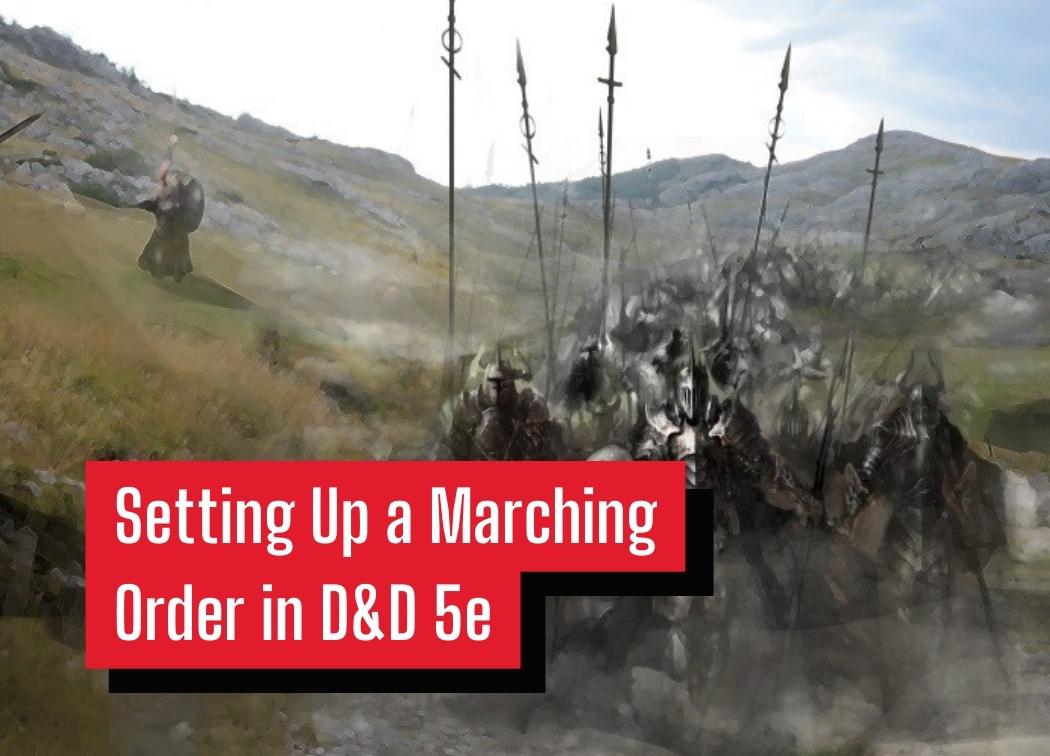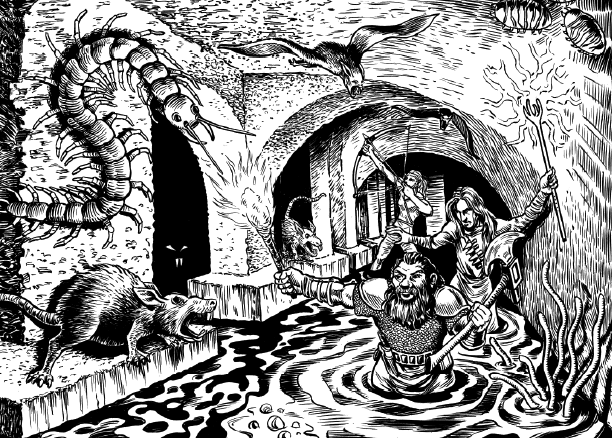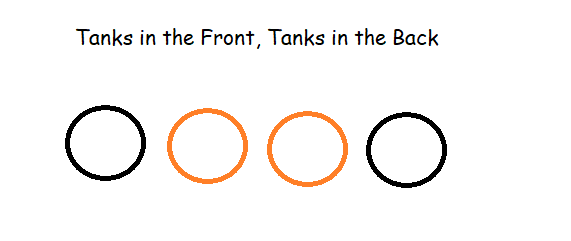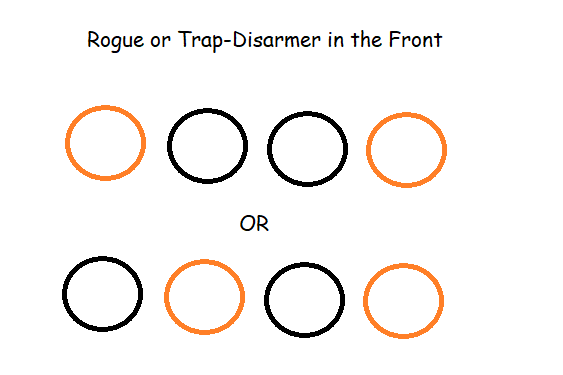Setting Up a Marching Order in D&D 5e

Determining your marching order when trekking through a hidden temple, dark dungeon, or forest pathway isn’t a tricky decision. However, it’s a micro-decision that can give a party a tactical advantage if they select the most ideal marching order for the situation they’re in.
Everyone’s probably been in this scenario. The party is forced to travel in a location where they can no longer travel as a blob and needs to travel at 1, 2, or even 3 abreast through this path. The DM will then ask you for your marching order which will a) help them set the scene and b) help the DM make decisions regarding combat encounters, traps, and other such events that may happen in this location.
Every class in D&D 5e has its strengths, unique playstyles, and of course, weaknesses. All of these items factor heavily into where a character should fit into the party’s typical marching order.
Let’s talk about how to make a basic marching order and how different scenarios and settings may force your group to shake it up as you explore new areas.

What is a Marching Order
A marching order is an ordered list that dictates what party member is in what position in the formation. It’s a list of who is walking where as you traverse a restrictive environment like a cave.
In D&D 5e there are a couple of rules involved in creating a marching order. Fret not, they’re not complex!
Each row of a marching order is called a rank. The first row where the leader(s) are located is called the front rank. The last row is considered the back rank. Every row between the front and back ranks are the middle ranks.
Easy enough, right?
If for some reason you only have two ranks in your party’s marching order, the formation will only have a front and back rank. For example, if the path allows two people to walk side-by-side and the party only has four people in it.
When the DM asks the party for the marching order they’ll give the party all of the environmental constraints of the location they’re in. All the party needs to know concerning their formation is how many people can walk side-by-side. Once the party has that, they can give the DM their marching order and be on their way.
When Would You Call for a Marching Order?
There are two primary scenarios where the DM typically will ask for the marching order. The first is whenever you are traversing a dungeon or any other locale with a limited amount of space. The second is when you are traveling, typically in a dangerous area.
The reason for this is that the DM may have random encounters, planned encounters, traps, or any number of different obstacles to throw at the party. They need to know who is going to be where to know who will be impacted by these obstacles first.
Why Does it Matter?
Having all the information on-hand is important for a DM during game-time. For one, it allows them to make appropriate decisions based on what the party is doing and where they are located. Mix this in with the DM’s meta-knowledge regarding the party’s spells, background, class features, and other traits and you’ll have a DM that is well-prepared to narrate the scene and provide engaging encounters for the party to interact with.
Knowing the marching order is only a small portion of this knowledge that the DM leans on. However, in the appropriate scenario, the marching order can tell the DM a lot about the party.
For example, putting a well-armored character in the front and back ranks with the two poorly-armored characters in the middle tells the DM that the party is anticipating danger from both sides as they walk down a dimly-lit hallway.
Some locations such as a cave or a forest are ideal locations for ambushes! These areas are where you’ll want to have a strong formation to protect your glass cannons and other less defensively-gifted party members. The DM’s creatures will try to find holes in your formation to make the most out of their ambush so try and anticipate this.
Potential Formations
I included what I believe to be the three staple marching orders alongside one that “breaks” the mechanic so to speak. Let me know in the comments if you can think of others!
Tanks in the Front, Tanks in the Back

In this formation, we put our tanks in both the front and back rows of the marching order. For the record, if your group doesn’t have dedicated tanks, consider your beefy melee frontline characters as the “tanks” throughout the rest of this article.
This formation is commonly used when the party is on high-alert for danger coming at them from all sides. By having a tank in the back, the party’s squishier characters are protected from assailants coming from every direction.
For example, if the party is stumbling about in the middle of a dungeon and they are not 100% certain if they have cleared everything behind them it’ll be wise to use this formation.
Ranged in the Back, Melee in the Front

If the party is certain or at least very confident that they will not be subjected to an attack from behind, they’ll probably utilize this formation. Here, the squishier ranged characters will sit in the back and lob safely lob attacks at their enemies and the melee characters have a two-rank wall blocking enemies from reaching them.
This is also an ideal offensive formation. Specifically, this marching order ensures that the melee units in the party will be able to engage with the enemy A.S.A.P. This formation is even more efficient if the melee character in the 2nd row fights with a polearm or a weapon with the reach property.
Rogue or Trap-Disarmer in the Front

If you’re in a trap-riddled dungeon the ideal spot for your rogue or trap-disarmer is going to be where they can see the traps. Ergo, they will be located in the front rank of the marching order, even if someone tankier has to go one rank behind them.
This formation doesn’t change much outside of swapping the rogue to the first position or the first rank of the marching order. If you want to min-max this portion of the game you could always have one of the tanks pick up proficiency in theives’ tools and Perception/Investigation so that you’ll never need to throw a rogue into the front rank of the formation.
Doing this, though, comes at a cost. If the tank isn’t already dexterous they won’t be nearly as efficient as a rogue or the party’s trap-disarmer. Plus, rogues can hold their own in combat thanks to their high Dexterity and Cunning Action.
Being upfront allows your sneaky friend to have first dibs on making Perception or Investigation checks to suss-out any traps, hidden passages, or potential danger.
Yes, even if they are primarily a ranged combatant your trap-disarmer should be at least attempting to run interference before the party’s frontline has to deal with a deadly trap. The downside of this formation is that the party will need to quickly reposition at the beginning of combat if one breaks out.
You’d also run this same formation if you had a ranged ranger leading the party through the wilderness.
Heavily Armored Ranged Units in the Back
Every mechanic in D&D 5e exists to be broken or at least nullified. There are a few classes and character builds that I believe can make the marching order decision practically irrelevant.
In this scenario, I’m talking about ranged combatants that can be well-armored and have at least a decent health pool. A cleric in heavy armor or at least medium armor with a shield is a perfect example of this.
They can operate perfectly in the very back of the marching order while still being able to block or take a few hits should an enemy come up from behind the party. Other examples can include a well-armored ranger, fighters with the Archery Fighting Style, and spellcasting druids with shields.
An Eldritch Knight Fighter could also be considered for this position, although most Eldritch Knights will still operate best in the frontlines they still have access to ranged magic that they can utilize.
Having one of these characters or others like them in your party can essentially ensure that your back rank is always well-protected.
Conclusion
All in all, this is a very minor travel mechanic. Most groups don’t need to think hard about optimizing their marching order once they have a basic understanding of who should go where. Sure, your marching order will change depending on the environment, but still, it’s not all that difficult to position yourselves.
It’s hard to get a marching order wrong. The whole point of it is to put your low-AC and low-HP characters in the safest positions in the formation. To do this, the group needs to read the scenario they’re in and determine where that may be.
Generally speaking, this will mean that the squishy characters are located in either the middle of the formation or in the very back. The only exception to this rule is if you need your rogue in the front ranks to check for traps in a dungeon, but even then, most rogues have a respectable AC due to their Dexterity.
The marching order won’t necessarily make or break an encounter for the party unless they screw it up. However, it’s interesting to break these types of gameplay decisions down to understand how and why we make the choices we make in-game.
